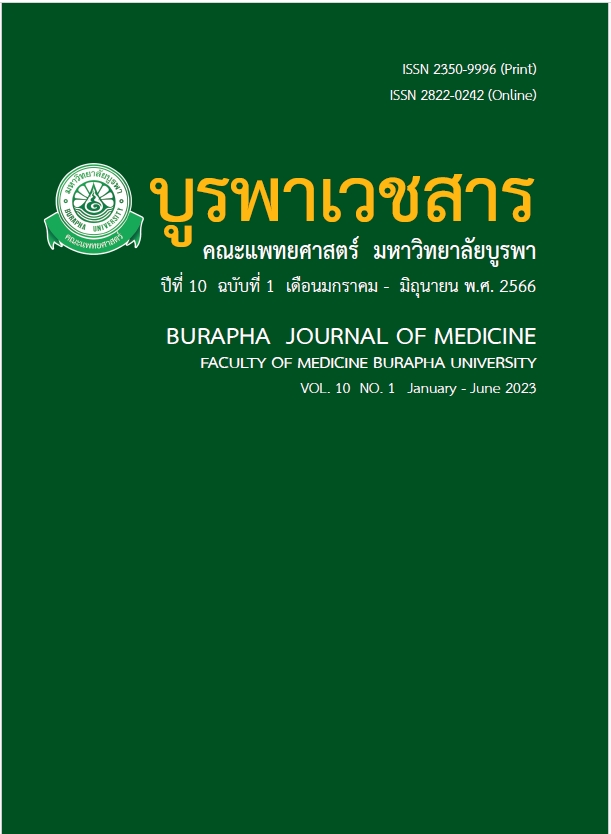การยอมรับและความพึงพอใจต่อตำรับข้าวหลามที่ใช้ไอโซมอลทูโลสเป็นสารให้ความหวานแทนน้ำตาล
คำสำคัญ:
ข้าวหลาม , ไอโซมอลทูโลส, สารให้ความหวานแทนน้ำตาล , การประเมิณคุณภาพทางประสาทสัมผัสบทคัดย่อ
บทคัดย่อ
บริบท ข้าวหลามเป็นของว่างที่มีชื่อเสียงของจังหวัดชลบุรี อย่างไรก็ตามข้าวหลามทั่วไปมีน้ำตาลเป็นส่วนประกอบในปริมาณสูง ซึ่งไอโซมอลทูโลสเป็นสารให้ความหวานชนิดหนึ่งที่มีความปลอดภัยและนิยมใช้ในปัจจุบัน
วัตถุประสงค์ เพื่อพัฒนาผลิตภัณฑ์ทางเลือกด้านสุขภาพ คือข้าวหลามที่ใช้ไอโซมอลทูโลสเป็นสารให้ความหวานแทนน้ำตาล
วิธีการศึกษา คัดเลือกอาสาสมัครที่มีสุขภาพดีในพื้นที่ตลาดหนองมน จังหวัดชลบุรี จำนวน 30 คน เพื่อทำการทดสอบการยอมรับและความพึงพอใจทางประสาทสัมผัสที่มีต่อข้าวหลาม 2 สูตร ได้แก่ สูตรต้นตำรับที่ใช้น้ำตาล เป็นส่วนประกอบ และสูตรไอโซมอลทูโลสที่ใช้ทดแทนน้ำตาล
ผลการศึกษา ข้าวหลามสูตรไอโซมอลทูโลสมีคะแนนความพึงพอใจด้านสีน้อยกว่าสูตรต้นตำรับอย่างมีนัยสำคัญทางสถิติ (p<0.05) แต่อย่างไรก็ตาม เมื่อพิจารณาคะแนนความพึงพอใจในด้านอื่น ๆ พบว่าข้าวหลามสูตรไอโซมอลทูโลสไม่มีความแตกต่างกับสูตรต้นตำรับในทุกด้านและมีคะแนนความพึงพอใจโดยภาพรวมอยู่ในเกณฑ์ที่อาสาสมัครให้การยอมรับ
สรุป ข้าวหลามสูตรที่ใช้ไอโซมอลทูโลสเป็นสารให้ความหวานทดแทนน้ำตาลได้รับการยอมรับและพึงพอใจจากอาสาสมัครเทียบเท่าสูตรต้นตำรับ
เอกสารอ้างอิง
Gowshall M, Taylor-Robinson SD. The increasing prevalence of noncommunicable diseases in low-middle income countries: the view from Malawi. Int J Gen Med. 2018; 11: 255-64.
Islam SMS, Purnat DT, Phuong NTA, Mwingira U, Schacht K, Fröschl G. Noncommunicable diseases (NCDs) in developing countries: a symposium report. J Glob Health. 2014; 10: 81.
Linkeviciute-Ulinskiene D, Kaceniene A, Dulskas A, Patasius A, Zabuliene L, Smailyte G. Increased mortality risk in
people with Type 2 diabetes mellitus in Lithuania. Int J Environ Res Public Health. 2020; 17: 6870.
Kaiser A, Vollenweider P, Waeber G, Marques-Vidal P. Prevalence, awareness and treatment of type 2 diabetes mellitus in Switzerland: the CoLaus study. Diabet Med. 2012; 29: 190-7.
Chatelan A, Gaillard P, Kruseman M, Keller A. Total, added, and free sugar consumption and adherence to guidelines in Switzerland: Results from the First National Nutrition Survey menuCH. Nutrients. 2019; 11: 1117.
Neville SE, Boye KS, Montgomery WS, Iwamoto K, Okamura M, Hayes RP. Diabetes in Japan: a review of disease burden and approaches to treatment. Diabetes Metab Res Rev. 2009; 25: 705-16.
Fujiwara A, Murakami K, Asakura K. Estimation of starch and sugar intake in a Japanese population based on a newly developed food composition database. Nutrients. 2018; 10: 1474.
Aekplakorn W, Chariyalertsak S, Kessomboon P, Assanangkornchai S, Taneepanichskul S, Putwatana P. Prevalence of diabetes and relationship with socioeconomic status in the Thai population: National Health Examination Survey, 2004–2014. J Diabetes Res. 2018;
: 1654530.
Kriengsinyos W, Chan P, Amarra MSV. Consumption and sources of added sugar in Thailand: a review. Asia Pac J Clin Nutr. 2018; 27: 262-83.
Rippe JM, Sievenpiper JL, Lê KA, White JS, Clemens R, Angelopoulos TJ. What is the appropriate upper limit for added sugars consumption?. Nutr Rev. 2017; 75: 18-36.
Suraphad P, Suklaew P, Ngamukote S, Adisakwattana S, Mäkynen K. The Effect of isomaltulose together with green tea on glycemic response and antioxidant capacity: A single-blind, crossover study in healthy subjects. Nutrients. 2017; 9: 464.
Sittipran W, Salubsri S, Kaigate C. Effect of Self-monitoring Blood Glucose Program in Poorly Controlled Type 2 Diabetes Mellitus Patients on Glycosylate Level. J Prapokklao Hosp Clin Med Educat Center. 2015; 32: 68-82.
Wichchukit S, O’Mahony M. The 9-point hedonic scale and hedonic ranking in food science: some reappraisals and alternatives. J Sci Food Agric. 2015; 95: 2167-78.
Manickavasagan A, Abbas I, Cork L, Khan MA, Al-Rahbi S, Subramanian K, et al. Acceptability of reformulated whole-grain products using net acceptance score (NAS) and relative acceptance score (RAS). IJNPND. 2016; 6: 12-22.
Hertzog MA. Considerations in determining sample size for pilot studies. Res Nurs Health. 2008; 31: 180-91.
Singh-Ackbarali D, Maharaj R. Sensory Evaluation as a Tool in Determining acceptability of innovative products developed by undergraduate students in food science and technology at The University of Trinidad and Tobago. Journal of Curriculum and Teaching. 2014; 3: 10-27.
Rojjanawanicharkorn A, Luangpituksa P, Siriwedchayant S, Changcharoen T. The situation of using artificial sweetener instead of sugar in instant beverage powder. JNAT. 2017; 52: 12-22.
Gao J, Brennan MA, Mason SL. Effects of Sugar Substitution with “Stevianna” on the Sensory Characteristics of Muffins. Journal
of Food Quality. 2017; 8636043.
Chinachote P, editor. The 15th Food Innovation Asia Conference 2013 proceedings; Jub 13-14, 2013; BITEC Bangna, Bangkok: Mae Joe University Publishinh; 2013.
Bagheri F, Radi M, Amiri S. Use of sweetener stevioside for produce dietary breakfast cream. Agric Sci Dev. 2014; 3: 284-91.
Tuderman AK, Strachan CJ, Juppo AM. Isomalt and its diastereomer mixtures as stabilizing excipients with freeze-dried lactate dehydrogenase. Int J Pharm. 2018; 538: 287-95.
Atkinson FS, Foster-Powell K, Brand-Miller JC. International tables of glycemic index and glycemic load values: 2008. Diabetes Care. 2008; 31: 2281–3.
Maeda A, Miyagawa J, Miuchi M, Nagai E, Konishi K, Matsuo T, Tokuda M, Kusunoki Y, Ochi H, Murai K, Katsuno T, Hamaguchi T, Harano Y, Namba M. Effects of the naturally occurring disaccharides, palatinose and sucrose, on incretin secretion in healthy non-obese subjects. J Diabetes Investig. 2013; 4: 281-6.
Ang M, Linn T. Comparison of the effects of slowly and rapidly absorbed carbohydrates on postprandial glucose metabolism in type 2 diabetes mellitus patients: a randomized trial. Am J Clin Nutr. 2014; 100: 1059-68.
Wang L, Wang H, Zhang B, Popkin BM, Du S. Elevated fat Intake Increases body weight and the risk of overweight and obesity among Chinese Adults: 1991–2015 Trends. Nutrients. 2020; 12: 3272.
ดาวน์โหลด
เผยแพร่แล้ว
รูปแบบการอ้างอิง
ฉบับ
ประเภทบทความ
สัญญาอนุญาต
ลิขสิทธิ์ (c) 2023 Burapha University

อนุญาตภายใต้เงื่อนไข Creative Commons Attribution-NonCommercial-NoDerivatives 4.0 International License.



